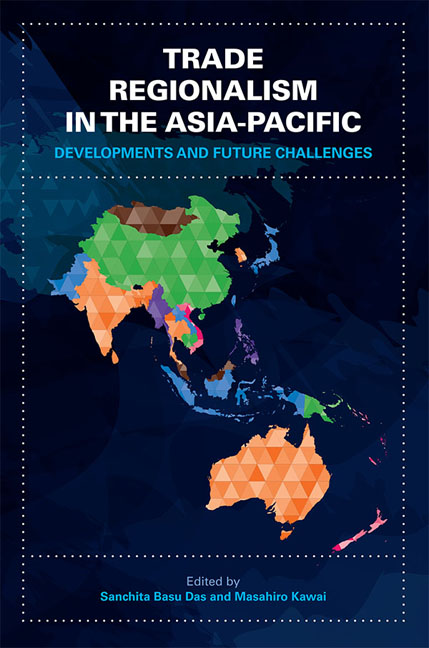Book contents
- Frontmatter
- Contents
- Foreword
- Acknowledgments
- List of Abbreviations
- The Contributors
- 1 Introductory Overview — Trade Regionalism in the Asia-Pacific: Developments and Future Challenges
- I The Trans-Pacific Partnership (TPP) Agreement
- II The Regional Comprehensive Economic Partnership (RCEP) Agreement
- III Regional Economic Integration: A Multi-stage Approach
- 10 AEC and ASEAN+1 FTAs: Progress, Challenges and Future
- 11 CJK FTA Rationale, Prospects and Challenges
- IV Old and Emerging Approaches to Asia-Pacific Regional Integration
- V Asia-Pacific Regional Integration: Towards Convergence?
- Index
11 - CJK FTA Rationale, Prospects and Challenges
from III - Regional Economic Integration: A Multi-stage Approach
Published online by Cambridge University Press: 05 July 2016
- Frontmatter
- Contents
- Foreword
- Acknowledgments
- List of Abbreviations
- The Contributors
- 1 Introductory Overview — Trade Regionalism in the Asia-Pacific: Developments and Future Challenges
- I The Trans-Pacific Partnership (TPP) Agreement
- II The Regional Comprehensive Economic Partnership (RCEP) Agreement
- III Regional Economic Integration: A Multi-stage Approach
- 10 AEC and ASEAN+1 FTAs: Progress, Challenges and Future
- 11 CJK FTA Rationale, Prospects and Challenges
- IV Old and Emerging Approaches to Asia-Pacific Regional Integration
- V Asia-Pacific Regional Integration: Towards Convergence?
- Index
Summary
INTRODUCTION
Northeast Asia is an active region that forms one important pillar of the world economy. Considering the cumulative effect of the population and global trade volume of each economy, the region has the potential to create one of the largest economic blocs in the world, on par with the European Union (EU) and North American Free Trade Agreement (NAFTA). The financial and debt crisis derived from the United States and the EU during 2008–12 has increased the importance of further regional economic cooperation in the region. In order to achieve greater and more effective regional cooperation, China, Japan, and South Korea — the key players in the Northeast Asian region — should continue their efforts to find areas where the countries share common economic objectives and look for concrete measures to pursue them.
One viable option to spur economic cooperation among the three countries is to pursue a Free Trade Agreement (FTA). Heeding the broad consensus on the need of a China–Japan–Korea FTA (CJK FTA), the governments of the three countries recently launched the negotiations for a CJK FTA in November 2012. This was an achievement after nearly ten years of in-depth research on the needs and possible impacts of a CJK FTA on each country. However, the possibility of concluding a high standard CJK FTA seems dim as competition between major industries among the three countries is intensifying (Jeong and Bang 2011). Nevertheless, the intensified production network of Northeast Asia, labelled as “Factory Asia” (Baldwin and Kawai 2013; Baldwin 2008), the increased overlapping FTAs in East Asia, the potential of Northeast Asia to evolve into a “Global Mall” (Helble and Ngiang 2014), and the recent trend of pursuing mega-FTA blocs by advanced countries all support the argument that a CJK FTA is a viable option to enrich the region as a whole. The important considerations here are to what extent the region should liberalize and through which path the negotiations should take.
LITERATURE REVIEW
Many studies have examined the necessity of a CJK FTA. By assessing the economic impacts of a CJK FTA via a computable general equilibrium (CGE) model, the Trilateral Joint Research project concluded that a CJK FTA “will be a win-win-win strategy bringing about benefits to all members” (DRC, NIRA and KIEP 2008, p. 3).
- Type
- Chapter
- Information
- Trade Regionalism in the Asia-PacificDevelopments and Future Challenges, pp. 213 - 236Publisher: ISEAS–Yusof Ishak InstitutePrint publication year: 2016

